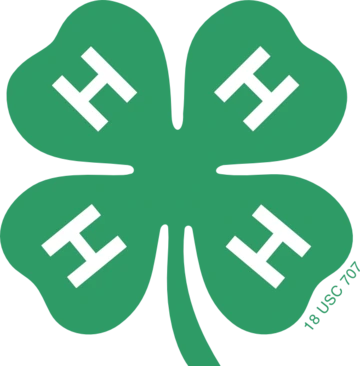4-H 101
Who 4-H Serves

While it has its beginnings in rural America, 4-H now serves young people and volunteers from major urban centers and from suburban communities and rural non-farm settings as well. 4-H is an organization that serves youth--not just boys and not just girls. From 4-H clubs to special interest groups to school enrichment projects, 4-H automatically includes both boys and girls in activities. As a result, more well-rounded young people are developed through 4-H. Boys often enroll in projects such as foods, clothing and home environment, while girls frequently enroll in wood science, large animal projects and horticulture projects. In addition, such 4-H activities as camping, state leadership conferences and citizenship trips are participated in equally by boys and girls.
4-H and families
4-H encourages and rewards participation by the entire family. Youth enroll as 4-H members. Other family members help out as club leaders, project leaders, meeting helpers, transportation aides--you name it. Four-H is definitely a family affair.
Most importantly, 4-H families work together on projects and activities, attend meetings and events together and learn together through 4-H. In the process, family members learn more about each other through their involvement in 4-H. They may even become better families, appreciating each other's strengths and talents just a bit better.
4-H and the community
4-H doesn't stop with its impact on young people and their families. An integral part of the popularity of 4-H is that it reaches into the communities in which these families live. Many 4-H clubs, for example, meet in churches, schools and community centers. As part of their 4-H experience, young people are encouraged to develop a better understanding of their communities and to contribute to community betterment.
4-H also draws from community resources to enhance the educational experience of 4-H members. Guest speakers, community field trips and fairs are examples of ways in which communities get involved.
4-H in Arizona History
The Arizona 4-H program began in 1913. Volunteer leader George T. Peabody organized a Boy's Cotton Club in Chandler. Then, the U.S. Smith-Lever Act was passed in 1914. Following the law's passage, Professor Stanely F. Morse, of The University of Arizona, College of Agriculture Experiment Station, organized 12 cotton, corn, and grain sorghum 4-H clubs.
Canning clubs and pig and poultry clubs were organized in 1915 by Leland Park. He was a University of Arizona State Agent who became the first employee to devote full time to clubs for boys and girls.
In the early years, most clubs were organized through schools, with teachers serving as leaders. Boys' and girls' clubs became known as "4-H Clubs" in the early 1930's. 4-H Clubs started in Mohave County in 1958.
In recent years, 4-H Youth Development programs have been organized in the communities with a continued emphasis on a balance of experiences for young people in project work, personal development opportunities, leadership and citizenship.
Organizational Structure
A volunteer leader is the backbone of 4-H Youth Development in Arizona. Their leadership, under the guidance and direction of professional 4-H personnel, allows us to reach a large number of young people in Arizona. This partnership of 4-H Youth Development professionals, working cooperatively with certified volunteer leaders, provides non-formal educational programs and experiences for more than 17,000 young Arizonans.
4-H is the youth education component of Cooperative Extension, which is conducted jointly by the U.S. Department of Agriculture, the state land grant university (The University of Arizona), and your county government.
Cooperative Extension was established to educate, to interpret, and to encourage the practical use of knowledge coming from scientific research. The name "Extension" comes from the mission of the agency to "extend knowledge to the public."
4-H Youth Development has a unique link with a variety of resources from The University of Arizona.
Organization
There are different levels of 4-H Youth Development participation and involvement, all of which can be beneficial to the individual. In Arizona youth can participate in 4-H Youth Development in an organized 4-H club/group; short term interest groups; school enrichment programs; family clubs; instructional TV; and in self-determined projects.
The Arizona 4-H Youth Development program year is October 1 through September 30.
To keep youth the focus of the Arizona 4-H Youth Development program and to assure that 4-H members have an active voice in program development, 4-H youth will be members of all program advisory and program activity committees at the state and local levels. One third of the membership of all such committees should be 4-H youth, actively recruited to represent the membership at large. Youth members will have decision making powers and voting rights

